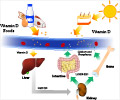Vitamin D deficiency probably responsible for unexplained disparities in cancer survival rates amid African and White Americans, claims new study.

In addition, papers have reported that those with higher serum 25-hydroxyvitamin D concentrations when diagnosed with seven types of cancer have higher cancer-specific and all-cause survival rates.
Much of the journal literature regarding disparities in cancer survival rates between African- and white-Americans examines the roles of socioeconomic status, stage at diagnosis, and treatment.
While these factors do explain a significant portion of the disparities, most of the studies report that these factors do not explain all of the disparities.
The journal literature indicates that there are disparities for 13 types of cancer after consideration of socioeconomic status, stage at diagnosis and treatment - bladder, breast, colon, endometrial, lung, ovarian, pancreatic, prostate, rectal, testicular, and vaginal cancer. Hodgkin's lymphoma, and melanoma.
Solar UVB doses and-or vitamin D have been reported inversely correlated with incidence and-or mortality rates for all of these cancers.
Advertisement
However, the effect for other cancers may be lower than for breast and colorectal cancer.
Advertisement
Dark skin is an advantage in Africa, where solar UVB doses are quite high, but a disadvantage in the United States, where it isn't.
"Raising vitamin D concentrations to 40 ng per ml by taking 1000-4000 IU per d vitamin D3 supplements is the easiest thing African-Americans can do to reduce the heavy burden of cancer they experience. In addition to reducing the risk of cancer, vitamin D would also reduce the risk of cardiovascular disease, diabetes mellitus, respiratory infections and many other chronic and infectious diseases," William B. Grant, co-author of the paper and director of Sunlight, Nutrition and Health Research Center, said.
According to Alan N. Peiris, M.D,PhD. FRCP(Lon), a co-author and Chief of Endocrinology at Mountain Home VAMC and East Tennessee State University, monitoring of vitamin D status is often inadequate.
Given the wide range of dose responses to vitamin D replacement, it is prudent to monitor levels of 25(OH)D following initiation of dosing. This enables maintaining desired levels over the long term which may facilitate accrual of maximal benefit.
"Vitamin D deficiency is at epidemic proportions in the United States and it is far worse among blacks. This paper provides much needed insight into the important role which vitamin D deficiency plays in helping to explain the significantly higher cancer incidence and mortality rates among African Americans," Emily Allison-Francis, author of the study, said.
Research into the basic science of vitamin D has demonstrated profound effects on cell proliferation, cell differentiation, angiogenic tumour factors and cell cohesion. Each of these factors plays a major role in the evolution and progression of cancers.
Testing for 25 (OH) vitamin D is simple, widely available and cost effective. Those who have the lowest 25 (OH) D levels have the most potential to gain from repletion. Based on the current state of knowledge, the risk - benefit of repletion of vitamin D stores is favourable.
More than 50 percent of Americans over 50 years of age will have one or more malignancies diagnosed. Hypovitaminosis D disproportionately affects African-Americans. It's time to level the playing field.
A study has been published in Dermato-Endocrinology.
Source-ANI















